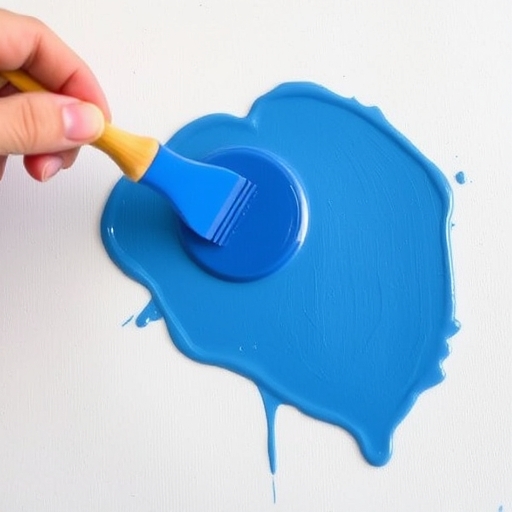Removing Acrylic Paint – A Comprehensive Guide
Acrylic paint, beloved for its vibrant colors and quick-drying time, can also be a source of frustration when it ends up where it’s not wanted. Whether you’ve had a painting mishap on your clothes, a rogue splatter on your furniture, or a less-than-perfect art project needs a redo, knowing how to remove acrylic paint effectively is crucial.
This guide covers various techniques for removing acrylic paint from different surfaces, providing you with the knowledge to tackle any paint-related predicament.
Acrylic Paint and its Removal Challenges
Acrylic paint’s fast-drying nature is both its strength and its weakness when it comes to removal. Once dry, it forms a durable, water-insoluble film, making it significantly harder to remove than water-based paints. The success of any removal method depends on several factors:
The surface: Porous surfaces like wood and fabric absorb the paint more readily, making complete removal difficult. Non-porous surfaces like glass and metal are generally easier to clean.
The paint’s age: Fresh paint is far easier to remove than paint that has had time to cure and bond with the surface.
The paint’s thickness: A thick layer of paint requires more aggressive methods than a thin splatter.
The surface’s finish: A glossy surface may be easier to clean than a matte surface, as the paint adheres less strongly.
Removing Acrylic Paint from Different Surfaces
This section details specific techniques for various surfaces. Remember to always test any cleaning method on an inconspicuous area first to avoid damaging the surface.
Removing Acrylic Paint from Fabric
Getting acrylic paint on your clothes can be disheartening, but quick action is key.
Fresh Paint: For fresh paint, immediately blot (don’t rub!) the stain with a clean cloth or paper towel to lift as much paint as possible. Then, rinse with cold water from the back of the fabric to push the paint out. Repeat until the stain is gone or significantly reduced. For stubborn stains, try a gentle detergent and cold water, then launder as usual.
Dried Paint: Dried acrylic paint on fabric often requires more forceful methods.
Soaking: Soak the fabric item in a mixture of warm water and laundry detergent for several hours, or even overnight. Gently agitate the fabric and rinse thoroughly.
Enzyme cleaner: Enzyme-based cleaners, specifically designed for stain removal, can be effective on dried acrylic. Follow the product instructions carefully.
Isopropyl Alcohol (Rubbing Alcohol): Apply rubbing alcohol directly to the stain, gently blotting with a clean cloth. This is more effective on synthetic fabrics; test it on natural fabrics in an inconspicuous area first.
Paint thinner (for stubborn cases): Use paint thinner only as a last resort and with extreme caution in a well-ventilated area, as it is highly flammable and toxic. Apply sparingly and blot gently, then rinse thoroughly.
Removing Acrylic Paint from Wood
Acrylic paint on wood is a challenge, especially on porous wood.
Fresh Paint: Scrape off as much paint as possible using a plastic scraper or putty knife. Then, wash the area with soapy water and a soft cloth.
Dried Paint: For dried paint, you may need more aggressive methods:
Heat gun: Carefully use a heat gun to soften the paint, then scrape it off with a putty knife. Be extremely cautious to avoid burning the wood.
Paint stripper: Chemical paint strippers can be effective but require careful following of instructions and good ventilation. Wear appropriate safety gear.
Sanding: Fine-grit sandpaper can remove dried paint, but it may also damage the wood’s finish. Start with a higher grit and work your way down if needed.
Removing Acrylic Paint from Glass and Metal
Glass and metal are relatively easy to clean, especially if the paint is fresh.
Fresh Paint: Wipe off fresh paint with a damp cloth or sponge. For stubborn spots, use warm soapy water.
Dried Paint: For dried paint, try the following:
Razor blade scraper: Carefully scrape off the paint using a razor blade. Be extremely cautious to avoid scratching the surface.
Isopropyl alcohol: Soak a cloth in isopropyl alcohol and apply it to the paint. Let it sit for a few minutes before wiping it off.
Commercial glass or metal cleaner: Many commercial cleaners are effective in removing dried acrylic paint from these surfaces.
Removing Acrylic Paint from Walls
Removing acrylic paint from walls depends greatly on the type of wall and the paint’s age.
Fresh Paint: Immediately blot up the excess paint with a clean damp sponge or cloth. For washable walls, gently wash the area with soapy water.
Dried Paint: Dried paint on walls often requires more effort:
Paint scraper: Carefully use a plastic scraper or putty knife to remove the dried paint. Be careful not to damage the wall’s surface.
Warm water and dish soap: For slightly textured walls, a solution of warm water and dish soap may be enough to soften and lift the paint. Scrub gently with a soft sponge or brush.
Magic Eraser: A melamine foam eraser (Magic Eraser) can effectively remove dried acrylic paint from some wall surfaces, but test it in an inconspicuous area first.
Preventing Acrylic Paint Accidents
Prevention is always better than cure. Here are some tips to avoid paint mishaps:
Proper preparation: Cover surfaces with drop cloths or plastic sheeting before painting.
Use painter’s tape: Tape off areas you don’t want to paint.
Wear protective clothing: Wear old clothes or an apron to protect your clothing.
Work in a well-ventilated area: This is especially important when using solvents.
Clean up immediately: Address spills and splatters as soon as they happen.
Comparison Table of Removal Methods
| Surface | Fresh Paint | Dried Paint | Cautionary Notes |
|---|---|---|---|
| Fabric | Blot, cold water, detergent | Soaking, enzyme cleaner, rubbing alcohol (test) | Rubbing alcohol can damage some fabrics. |
| Wood | Scrape, soapy water | Heat gun, paint stripper, sanding | Heat gun & strippers are dangerous; sanding can damage wood. |
| Glass/Metal | Damp cloth, soapy water | Razor blade, isopropyl alcohol, commercial cleaner | Razor blades can scratch; test cleaner first. |
| Walls | Blot, soapy water | Paint scraper, warm water & soap, Magic Eraser | Test any method in an inconspicuous area. |
FAQ
Q: Can I use bleach to remove acrylic paint?
A: Bleach is generally not recommended for removing acrylic paint, as it can damage many surfaces and may not be effective.
Q: Is it safe to use a heat gun to remove paint?
A: A heat gun can be effective, but it requires caution and should only be used by experienced individuals. Always maintain a safe distance and avoid overheating the surface.
Q: What is the best way to remove acrylic paint from my skin?
A: Wash the affected area thoroughly with soap and water. If the paint is stubborn, try using a gentle exfoliating scrub.
Q: My acrylic paint is completely dried and embedded in the surface. What should I do?
A: For completely embedded paint, you may need to consider professional help or accept the paint as part of the surface. Further attempts at removal may cause more damage than the paint itself.
This guide provides a comprehensive overview of acrylic paint removal techniques. Remember to prioritize safety, always test methods on an inconspicuous area first, and choose the approach best suited to your specific surface and the paint’s condition. If you are unsure about a particular method, it’s always best to consult a professional.

